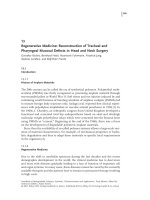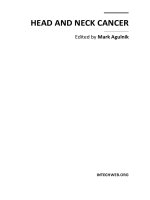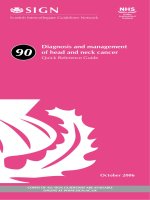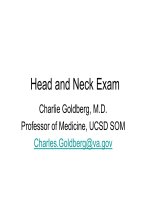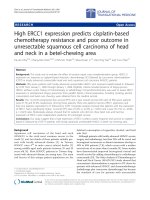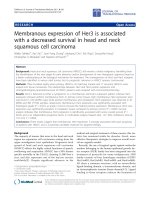Head and Neck Exam potx
Bạn đang xem bản rút gọn của tài liệu. Xem và tải ngay bản đầy đủ của tài liệu tại đây (6.18 MB, 38 trang )
Head and Neck Exam
Charlie Goldberg, M.D.
Professor of Medicine, UCSD SOM
Observation and Palpation
• Inspection face & neck:
– Does anything appear out
of ordinary in Head &
Neck?
– Bumps/lumps,
asymmetry, swelling,
discoloration,
bruising/trauma?
– anything hidden by hair?
Note right sided neck/jaw area swelling
and R v L asymmetry
• Inspection & palpation of
scalp, hair
Lymph Nodes of Head & Neck Physiology
• Major lymph node groups located
symmetrically either side of head & neck.
• Each group drains specific region
Lymph Node Enlargement – Major
Causes
• Enlarged if inflammation (most commonly
infection) or malignancy
Infection: Acute, tender, warm
– Primary region drained also involved (e.g neck nodes
w/strep throat)
– Sometimes get diffuse enlargement in response to
generalized infection or systemic inflammatory process
(.e.g TB, HIV, Mono)
Malignancy:
– Slowly progressive, firm, multiple nodes involved, stuck
together & to underlying structures.
– Primary site malignancy could be nodes (e.g.
lymphoma) or adjacent region (e.g. intra-oral squamous
cell ca)
Lymph Node Anatomy &
Drainage
Ant Cerv Throat, tonsils, post
pharynx, thyroid
Post Cerv Back of skull
Tonsillar Tonsils, posterior
pharynx
Sub-Mandibular Floor of
mouth
Sub-Mental Teeth
Supra-Clavicular Thorax
Pre-Auricular Ear
Lymph Node Exam
• Gently walk fingers along general regions
– comparing R to L
Function CN 7 – Facial Nerve
Facial Symmetry & Expression Precise Pattern of Inervation
R UMN
R LMN Forehead
R LMN – Face
L UMN
L LMN Forehead
L LMN -Face
CN 7 – Exam
• Observe facial
symmetry
• Wrinkle
Forehead
• Keep eyes
closed against
resistance
• Smile, puff out
cheeks
Cute.. and symmetric!
Pathology: Peripheral CN 7 (Bell’s)
Palsy
Patient can’t close L eye, wrinkle L forehead or
raise L corner mouth L CN 7 Peripheral (i.e. LMN)
Dysfunction
Central (i.e. UMN) CN 7 dysfunction (e.g. stroke) - not shown: Can
wrinkle forehead bilaterally; will demonstrate loss of lower facial
movement on side opposite stroke.
Function CN 5 - Trigeminal
• Sensation:
– 3 regions of face: Ophthalmic, Maxillary &
Mandibular
• Motor:
– Temporalis & Masseter muscles
Function CN 5 – Trigeminal
(cont)
Motor
Temporalis
(clench teeth)
Sensory
Ophthalmic(V1)
Maxillary (V2)
Masseter (move
jaw side-side)
Mandibular (V3)
Corneal Reflex: Blink when cornea touched - Sensory CN 5, Motor CN 7
Testing CN 5 - Trigeminal
• Sensory:
– Ask pt to close eyes
– Touch ea of 3 areas (ophthalmic, maxillary, &
mandibular) lightly, noting whether patient detects
stimulus.
• Motor:
– Palpate temporalis & mandibular areas as patient
clenches & grinds teeth
Anatomy of Masseter and Temporalis Muscles
()
• Corneal Reflex:
– Tease out bit of cotton from q-tip - Sensory CN 5, Motor
CN 7
– Blink when touch cornea with cotton wisp
The Ear – Functional Anatomy and Testing
(CN 8 – Acoustic)
• Crude tests hearing – rub fingers next to
either ear; whisper & ask pt repeat words
• If sig hearing loss, determine Conductive
(external canal up to but not including CN
8) v Sensorineural (CN 8)
Inner Ear Anatomy
(www.ncbegin.org/audiology)
Animated Ear Function: />
Great Moments In The History of
Hearing
Horton Hears A Who!
Uncle Bill Hears Aunt Ruth!
CN 8 - Defining Cause of
Hearing Loss - Weber Test
• 512 Hz tuning fork - this
(& not 128Hz) is well
w/in range normal
hearing & used for
testing
– Get turning fork vibrate
striking ends against heel
of hand or
Squeeze tips between
thumb & 1st finger
• Place vibrating fork mid
line skull
• Sound should be heard
=ly R & L
bone
conducts to both sides.
CN 8 - Weber Test (cont)
• If conductive hearing
loss (e.g. obstructing
wax in canal on
L) louder on L as
less competing noise.
• If sensorineural on
L louder on R
• Finger in ear mimics
conductive loss
CN 8 - Defining Cause of
Hearing Loss - Rinne Test
• Place vibrating 512 hz
tuning fork on mastoid
bone (behind ear).
• Patient states when can’t
hear sound.
• Place tines of fork next to
ear should hear it again
– as air conducts better
then bone.
• If BC better then AC,
suggests conductive
hearing loss.
• If sensorineural loss,
then AC still > BC
Note: Weber & Rinne difficult to perform in Anatomy lab due to competing
noise – repeat @ home in quiet room!
Examining the External Structures of
The Ear - Observation
Helix
Tragus
Mastoid
External
Canal
Note: Picture on L normal external ear; picture on
R swollen external canal, narrowed by
inflammation
Anti-Helix
Lobe
Internal Ear Anatomy
Inner Ear Anatomy
(www.ncbegin.org/audiology)
Normal Tympanic Membrane
NOSE
Long Process
Malleus
Incus
Left Ear –
Malleus points
down and back
Short Process
Malleus
Umbo
Cone of
Light
Images courtesy American Academy of Pediatrics
/>
Selected Tympanic Membrane
Pathology
Normal
University of Toronto - Otitis Media
University of Toronto Perforated Tympanic Membrane
Normal
Images courtesy American Academy of
Pediatrics
/>
University of Toronto - Wax
Using Your Otoscope
• Make sure battery’s
charged!
• Gently twist Otoscopic
Head (clockwise) onto
handle
• Twist on disposable,
medium sized speculum
• Hold in R hand R ear,
L hand L ear
Otoscope W/Magnified Viewing
Head
• Advantage magnified
view, larger field
• Speculum twists on;
viewing same as for
conventional head
• Rotate wheel w/finger
while viewing tympanic
membrane to enhance
focus (default setting is
green line)
•
Speculum
Focus
Wheel
Viewing Window
Otosocopy Basics
• Make sure patient seated
comfortably & ask them not
to move
• Place tip speculum in
external canal under direct
vision
• Gently pull back on top of
ear
• Advance scope slowly as
look thru window – extend
pinky to brace hand
• Avoid fast, excessive
movement – Stop if painful!
Look Dad - Otoscopy Sure is Easy!
